View in other NatureServe Network Field Guides
NatureServe
Montana
Utah
Wyoming
Idaho
Wisconsin
British Columbia
South Carolina
Yukon
California
New York
Silver-spotted Skipper - Epargyreus clarus
Native Species
Global Rank:
G5
State Rank:
S5
Agency Status
USFWS:
USFS:
BLM:
External Links
General Description
[From Ferris and Brown 1981; Scott 1986; Laybery et al. 1998; Opler and Wright 1999; Glassberg 2001; Pyle 2002] Forewing 2.5-2.6 cm in Rocky Mountain region. Large, forewing pointed. Overall coloration chocolate brown. Forewing crossed with brassy-gold spots, undersurface of hindwing with irregular metallic-silver band across disc.
Phenology
One flight, mid-June to mid-July in the north, Rocky Mountains, Sierra Nevada; several flights, May to September in southern California and Northeast; nearly all year in Florida (Scott 1986). May to September, but April to November in southern Texas, southern Arizona, Pacific lowlands; June and July in North Dakota and Canada (Glassberg 2001). Early June to late July in Canada (Layberry et al. 1998). Late May to early August in Rocky Mountain states (Ferris and Brown 1981). Late May to early August in Colorado (Scott and Scott 1978; Scott and Epstein 1987), early May to late July in Nebraska (Johnson and Nixon 1967; Dankert and Nagel 1988), early June to mid-July in North Dakota (McCabe and Post 1976), early April to late August in Oregon and Washington (Pyle 2002), late April to early September in Oregon (Warren 2005), late May to early August in British Columbia (Guppy and Shepard 2001).
Diagnostic Characteristics
Combination of size, base color, and markings (forewing brassy-gold spots, undersurface of hindwing with metallic-silver band across disc) are unique.
Species Range
Montana Range
Range Descriptions
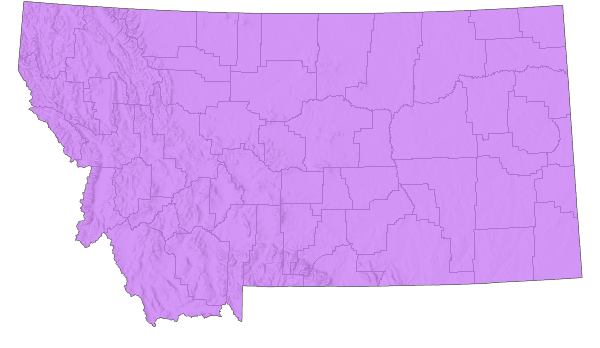
 Native
Native
Range Comments
Southern British Columbia east across southern Canada, south through most of continental US to northwestern Mexico; absent in western Texas, eastern New Mexico, and the Great Basin region (Scott 1986; Layberry et al. 1998; Opler and Wright 1999; Glassberg 2001); usualy below 2135 m elevation in the Rocky Mountain states, but sometimes to 3536 m (Ferris and Brown 1981), usually 1311 m to 2135 m elevation in Colorado, but often to 3536 m in some areas (Brown 1957; Scott and Scott 1978), near sea level to more than 1829 m elevation in Oregon (Warren 2005). In Montana, reported from at least 41 counties across the state (Kohler 1980; Stanford and Opler 1993; FLMNH Lepidopterists' Society database), to at least 1981 m elevation. Mainly common, but locally uncommon in northern California and the Pacific Northwest (Glassberg 2001).
Observations in Montana Natural Heritage Program Database
Number of Observations: 13
(Click on the following maps and charts to see full sized version)
Map Help and Descriptions
Relative Density
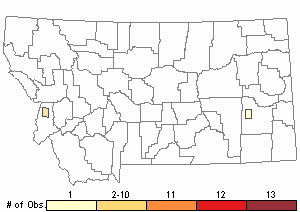
Recency
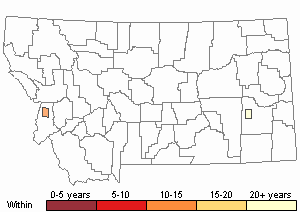
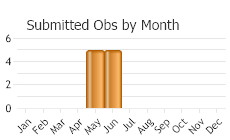
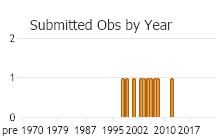
 (Observations spanning multiple months or years are excluded from time charts)
(Observations spanning multiple months or years are excluded from time charts)
Migration
Non-migratory.
Habitat
Foothill canyons, prairie streamsides and roadsides, fields, gardens, urban parks (Ferris and Brown 1981; Scott 1986; Dankert and Nagel 1988; Opler and Wright 1999; Glassberg 2001; Pyle 2002; Giuliano et al. 2004; Warren 2005), generally avoiding disturbed sites and riparian areas dominated by exotic Tamarix (Hogsden and Hutchinson 2004; Nelson 2007; Nelson and Wydoski 2008). Habitat in Montana not described but probably similar.
Food Habits
Larval food plants are native and exotic members of the Fabaceae, including Acacia, Amorpha, Amphicarpa, Apios, Astragalus, Desmodium (several species), Gleditsia, Glycyrrhiza, Lathyrus, Lespedeza, Lotus (multiple species), Phaseolus (multiple species), Pueraria, Robinia (several species), and Wisteria (Ferris and Brown 1981; Scott 1986, 1992, 2006; Layberry et al. 1998; Guppy and Shepard 2001; Pyle 2002; Graves and Shapiro 2003; Warren 2005; James and Nunnallee 2011). Adults feed on flower nectar (including Ageratum, Allium, Amaryllis, Apocynum, Asclepias, Bidens, Blephilia, Buddleia, Cardamine, Carduus, Centaurea, Cephalanthus, Chrysanthemum, Cirsium, Consolida, Cornus, Cosmos, Dahlia, Delphinium, Dipsacus, Epilobium, Eupatorium, Geranium, Gilia, Glycyrrhiza, Hesperis, Hydrangea, Impatiens, Iris, Jamesia, Justicia, Lantana, Lavandula, Liatris, Lonicera, Lupinus, Lythrum, Medicago, Mentha, Monarda, Myosotis, Nepeta, Ocimum, Oenothera, Orbexilum, Origanum, Penstemon, Petunia, Phaseolus, Philadelphus, Phlox, Pycanthemum, Rhaphanus, Rudbeckia, Rubus, Scabiosa, Scutellaria, Silphium, Symphorycarpos, Tamarix, Thalictrum, Tilia, Tradescantia, Trifolium, Verbena, Veronia, Viola, Zinnia), dung, and mud (Venables and Barrows 1985; Bray 1994; Pyle 2002; Tooker at al. 2002; Giuliano et al. 2004; Warren 2005; Scott 2014).
Reproductive Characteristics
Females lay eggs singly on undersurface of host plant leaves, usually top-most leaf of plant, rarely on uppersurface of leaf or stem, and rarely on nearby non-host plant (Scott 1986, 1992, 2006; James and Nunnallee 2011). Develop from egg hatch to L5 instar and pupae in about 30 days (mid-L3 to L5 instar and pupae in about 18 days), adults eclose (emerge) from non-diapause pupae in about 13-14 days, depending on temperature. Second broods overwinter as pupae (Scott 1979, 1986; James and Nunallee 2011). Larvae build silk-tied tubular leaf nest (larger with later instars), are solitary, feed on host plant leaves, leave nest at night to feed (Scott 1986, 1992, 2006; James and Nunnallee 2011). Males perch 1-2 m above ground throughout morning and early afternoon in gullies, woodland clearings, suburban yards, awaiting passing females (Scott 1975b, 1986).
Stewardship Responsibility
References
- Literature Cited AboveLegend:
 View Online Publication
View Online Publication Bray, T. 1994. Nectar-seeking visits by butterflies in a tallgrass prairie remnant in eastern Nebraska. Transactions of the Nebraska Academy of Sciences. 21:63-72.
Bray, T. 1994. Nectar-seeking visits by butterflies in a tallgrass prairie remnant in eastern Nebraska. Transactions of the Nebraska Academy of Sciences. 21:63-72. Dankert, N.E. and H.G. Nagel. 1988. Butterflies of the Niobrara Valley Preserve, Nebraska. Transactions of the Nebraska Academy of Sciences 16:17-30.
Dankert, N.E. and H.G. Nagel. 1988. Butterflies of the Niobrara Valley Preserve, Nebraska. Transactions of the Nebraska Academy of Sciences 16:17-30. Ferris, C.D. and F.M. Brown (eds). 1981. Butterflies of the Rocky Mountains. Univ. of Oklahoma Press. Norman. 442 pp.
Ferris, C.D. and F.M. Brown (eds). 1981. Butterflies of the Rocky Mountains. Univ. of Oklahoma Press. Norman. 442 pp. Glassberg, J. 2001. Butterflies through Binoculars: A Field Guide to the Butterflies of Western North America. Oxford University Press.
Glassberg, J. 2001. Butterflies through Binoculars: A Field Guide to the Butterflies of Western North America. Oxford University Press. Graves, S.D. and A.M. Shapiro. 2003.Exotics as host plants of the California butterfly fauna. Biological Conservation 110: 413-433.
Graves, S.D. and A.M. Shapiro. 2003.Exotics as host plants of the California butterfly fauna. Biological Conservation 110: 413-433. Guppy, C.S. and J.H. Shepard. 2001. Butterflies of British Columbia: including western Alberta, southern Yukon, the Alaska Panhandle, Washington, northern Oregon, northern Idaho, northwestern Montana. UBC Press (Vancouver, BC) and Royal British Columbia Museum (Victoria, BC). 414 pp.
Guppy, C.S. and J.H. Shepard. 2001. Butterflies of British Columbia: including western Alberta, southern Yukon, the Alaska Panhandle, Washington, northern Oregon, northern Idaho, northwestern Montana. UBC Press (Vancouver, BC) and Royal British Columbia Museum (Victoria, BC). 414 pp. Hogsden, K.L. and T.C. Hutchinson. 2004. Butterfly assemblages along a human disturbance gradient in Ontario, Canada. Canadian Journal of Zoology 82: 739-748.
Hogsden, K.L. and T.C. Hutchinson. 2004. Butterfly assemblages along a human disturbance gradient in Ontario, Canada. Canadian Journal of Zoology 82: 739-748. James, D.G. and D. Nunnallee. 2011. Life histories of Cascadia butterflies. Corvallis, OR: Oregon State University Press. 447 p.
James, D.G. and D. Nunnallee. 2011. Life histories of Cascadia butterflies. Corvallis, OR: Oregon State University Press. 447 p. Johnson, K. and E. S. Nixon. 1967. The Rhopalocera of northwestern Nebraska. American Midland Naturalist 78:508-528.
Johnson, K. and E. S. Nixon. 1967. The Rhopalocera of northwestern Nebraska. American Midland Naturalist 78:508-528. Kohler, S. 1980. Checklist of Montana Butterflies (Rhopalocera). Journal of the Lepidopterists' Society 34(1): 1-19.
Kohler, S. 1980. Checklist of Montana Butterflies (Rhopalocera). Journal of the Lepidopterists' Society 34(1): 1-19. McCabe, T.L. and R.L. Post. 1976. North Dakota butterfly calendar (including possible strays). Journal of Research on the Lepidoptera 15:93-99.
McCabe, T.L. and R.L. Post. 1976. North Dakota butterfly calendar (including possible strays). Journal of Research on the Lepidoptera 15:93-99. Nelson, S.M. 2007. Butterflies (Papilionoidea and Hesperiodea) as potential ecological indicators of riparian quality in the semi-arid western United States. Ecological Indicators 7:469-480.
Nelson, S.M. 2007. Butterflies (Papilionoidea and Hesperiodea) as potential ecological indicators of riparian quality in the semi-arid western United States. Ecological Indicators 7:469-480. Nelson, S.M. and R. Wydoski.2008. Riparian butterfly (Papilionidae and Hesperioidea) assemblages assiciated with Tamarix-dominated, native vegetation-dominated, and Tamarix removal sites along the Arkansas River, Colorado, USA. Restoration Ecology 16:168-179.
Nelson, S.M. and R. Wydoski.2008. Riparian butterfly (Papilionidae and Hesperioidea) assemblages assiciated with Tamarix-dominated, native vegetation-dominated, and Tamarix removal sites along the Arkansas River, Colorado, USA. Restoration Ecology 16:168-179. Opler, P.A. and A.B. Wright. 1999. A field guide to western butterflies. Second edition. Peterson Field Guides. Houghton Mifflin Company, Boston, Massachusetts. 540 pp.
Opler, P.A. and A.B. Wright. 1999. A field guide to western butterflies. Second edition. Peterson Field Guides. Houghton Mifflin Company, Boston, Massachusetts. 540 pp. Pyle, R.M. 2002. The butterflies of Cascadia: a field guide to all the species of Washington, Oregon, and surrounding territories. Seattle Audubon Society, Seattle, Washington. 420 pp.
Pyle, R.M. 2002. The butterflies of Cascadia: a field guide to all the species of Washington, Oregon, and surrounding territories. Seattle Audubon Society, Seattle, Washington. 420 pp. Scott, J.A. 1975b. Mate-locating behavior of western North American butterflies. Journal of Research on the Lepidoptera 14:1-40.
Scott, J.A. 1975b. Mate-locating behavior of western North American butterflies. Journal of Research on the Lepidoptera 14:1-40. Scott, J.A. 1979. Hibernal diapause of North American Papilionoidea and Hesperioidea. Journal of Research on the Lepidoptera 18(3): 171-200.
Scott, J.A. 1979. Hibernal diapause of North American Papilionoidea and Hesperioidea. Journal of Research on the Lepidoptera 18(3): 171-200. Scott, J.A. 1986. The butterflies of North America: a natural history and field guide. Stanford University Press, Stanford, California.
Scott, J.A. 1986. The butterflies of North America: a natural history and field guide. Stanford University Press, Stanford, California. Scott, J.A. 1992. Hostplant records for butterflies and skippers (mostly from Colorado) 1959-1992, with new life histories and notes on oviposition, immatures, and ecology. Papilio new series #6. 185 p.
Scott, J.A. 1992. Hostplant records for butterflies and skippers (mostly from Colorado) 1959-1992, with new life histories and notes on oviposition, immatures, and ecology. Papilio new series #6. 185 p. Scott, J.A. 2006. Butterfly hostplant records, 1992-2005, with a treatise on the evolution of Erynnis, and a note on new terminology for mate-locating behavior. Papilio new series #14. 74 p.
Scott, J.A. 2006. Butterfly hostplant records, 1992-2005, with a treatise on the evolution of Erynnis, and a note on new terminology for mate-locating behavior. Papilio new series #14. 74 p. Scott, J.A. 2014. Lepidoptera of North America 13. Flower visitation by Colorado butterflies (40,615 records) with a review of the literature on pollination of Colorado plants and butterfly attraction (Lepidoptera: Hersperioidea and Papilionoidea). Contributions of the C.P. Gillette Museum of Arthopod Diversity. Fort Collins, CO: Colorado State University. 190 p.
Scott, J.A. 2014. Lepidoptera of North America 13. Flower visitation by Colorado butterflies (40,615 records) with a review of the literature on pollination of Colorado plants and butterfly attraction (Lepidoptera: Hersperioidea and Papilionoidea). Contributions of the C.P. Gillette Museum of Arthopod Diversity. Fort Collins, CO: Colorado State University. 190 p. Scott, J.A. and G.R. Scott. 1978. Ecology and distribution of the butterflies of southern central Colorado. Journal of Research on the Lepidoptera 17(2): 73-128.
Scott, J.A. and G.R. Scott. 1978. Ecology and distribution of the butterflies of southern central Colorado. Journal of Research on the Lepidoptera 17(2): 73-128. Scott, J.A. and M.E. Epstein. 1987. Factors affecting phenology in a temperate insect community. American Midland Naturalist 117(1): 103-118.
Scott, J.A. and M.E. Epstein. 1987. Factors affecting phenology in a temperate insect community. American Midland Naturalist 117(1): 103-118. Stanford, R.E. and P.A. Opler. 1993. Atlas of western USA butterflies: including adjacent parts of Canada and Mexico. Unpubl. Report. Denver and Fort Collins, Colorado 275 pp.
Stanford, R.E. and P.A. Opler. 1993. Atlas of western USA butterflies: including adjacent parts of Canada and Mexico. Unpubl. Report. Denver and Fort Collins, Colorado 275 pp. Tooker, J.F., P.F. Reagel, and L.M. Hanks. 2002. Nectar sources of day-flying lepidoptera of central Illinois. Annals of the Entomological Society of America 95(1): 84-96.
Tooker, J.F., P.F. Reagel, and L.M. Hanks. 2002. Nectar sources of day-flying lepidoptera of central Illinois. Annals of the Entomological Society of America 95(1): 84-96. Venables, B.A.B. and E.M. Barrows. 1985. Skippers: pollinators or nectar thieves? Journal of the Lepidopterists' Society 39:299-312.
Venables, B.A.B. and E.M. Barrows. 1985. Skippers: pollinators or nectar thieves? Journal of the Lepidopterists' Society 39:299-312. Warren, A.D. 2005. Lepidoptera of North America 6: Butterflies of Oregon, their taxonomy, distribution, and biology. Contributions of the C. P. Gillette Museum of Arthropod Diversity, Colorado State University. Fort Collins, Colorado. 406 pp.
Warren, A.D. 2005. Lepidoptera of North America 6: Butterflies of Oregon, their taxonomy, distribution, and biology. Contributions of the C. P. Gillette Museum of Arthropod Diversity, Colorado State University. Fort Collins, Colorado. 406 pp.
- Additional ReferencesLegend:
 View Online Publication
View Online Publication
Do you know of a citation we're missing? Allen, T.J., J.P. Brock, and J. Glassberg. 2005. Caterpillars in the field and garden: a field guide to the butterfly caterpillars of North America. Oxford University Press.
Allen, T.J., J.P. Brock, and J. Glassberg. 2005. Caterpillars in the field and garden: a field guide to the butterfly caterpillars of North America. Oxford University Press. Brock, J.P. and K. Kaufman. 2003. Kaufman Field Guide to Butterflies of North America. Houghton Mifflin Company, New York, NY 284 pp.
Brock, J.P. and K. Kaufman. 2003. Kaufman Field Guide to Butterflies of North America. Houghton Mifflin Company, New York, NY 284 pp. Forister, M.L., C.A. Halsch, C.C. Nice, J.A. Fordyce, T.E. Dilts, J.C. Oliver, K.L. Prudic, A.M. Shapiro, J.K. Wilson, J. Glassberg. 2021. Fewer butterflies seen by community scientists across the warming and drying landscapes of the American West. Science 371:1042-1045.
Forister, M.L., C.A. Halsch, C.C. Nice, J.A. Fordyce, T.E. Dilts, J.C. Oliver, K.L. Prudic, A.M. Shapiro, J.K. Wilson, J. Glassberg. 2021. Fewer butterflies seen by community scientists across the warming and drying landscapes of the American West. Science 371:1042-1045. Forister, M.L., E.M. Grames, C.A. Halsch, K.J. Burls, C.F. Carroll, K.L. Bell, J.P. Jahner, et al. 2023. Assessing risk for butterflies in the context of climate change, demographic uncertainty, and heterogeneous data sources. Ecological Monographs 93(3):e1584. https://doi.org/10.1002/ecm.1584
Forister, M.L., E.M. Grames, C.A. Halsch, K.J. Burls, C.F. Carroll, K.L. Bell, J.P. Jahner, et al. 2023. Assessing risk for butterflies in the context of climate change, demographic uncertainty, and heterogeneous data sources. Ecological Monographs 93(3):e1584. https://doi.org/10.1002/ecm.1584 Guiliano, W.M., A. Accamando, and E.J. McAdams. 2004. Lepidoptera-habitat relationships in urban parks. Urban Ecosystems 7:361-370.
Guiliano, W.M., A. Accamando, and E.J. McAdams. 2004. Lepidoptera-habitat relationships in urban parks. Urban Ecosystems 7:361-370.
- Web Search Engines for Articles on "Silver-spotted Skipper"
- Additional Sources of Information Related to "Insects"





